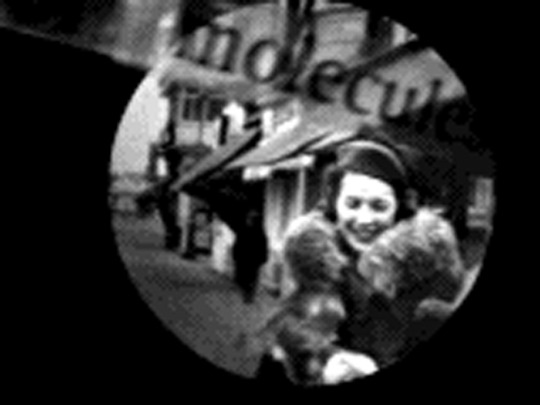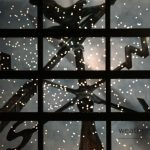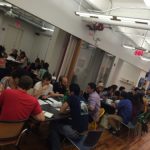Fellows at 30: Zoe Beloff
“I had come to the realization that my ideas didn’t fit into any known category”
This year marks the 30th anniversary of NYFA’s Artists’ Fellowship Program. To continue our 30th anniversary interview series we checked-in with two-time fellow in Computer Arts Zoe Beloff. Zoe works with a variety of media including installation, performance, film, and drawing. Her most recent exhibition, A World Redrawn: Eisenstein and Brecht in Hollywood, can be seen at the CUNY Graduate Center’s James Gallery through November 21, 2015.
NYFA: In 1997 at the insistence of our Artist Advisory Committee NYFA created the Fellowship category Computer Arts (today called Digital and Electronic Arts). At this time we were one of the first arts organizations to recognize this discipline. Can you recall what it was like to receive one of these early Computer Arts Fellowships? What do you think makes this discipline unique from others and what kind of work does it enable?
ZB: Of course I was thrilled to receive my grant. At the time I was something of a starving artist living in an illegal sublet on the Lower East Side and scraping a living as an adjunct teacher. So getting a grant to develop my project and the financial support to produce a professional CD-ROM was great. But as important was the encouragement, the fact that some people thought my work was worth funding. That’s why I think even small grants are great.
I started working on a computer in the mid 1990’s not because I was initially interested in technology but because I didn’t feel like there was any space for me in the better-established medias. I was trained as a painter and then as a filmmaker. I had come to the realization that my ideas didn’t fit into any known category – they didn’t fit feature filmmaking nor what is sometimes called “the American avant-garde” or experimental filmmaking.
In the summer of 1995, I felt very lost, without money to create work and without anywhere to show it, when quite by chance I stumbled up the idea of working with a webcam. It cost $99 and with it one could make tiny postage stamp size movies in flickery black and white. So I decided to open my own cinema online and make a new film every week. I started a serial called Beyond. There were no rules for this new medium. So I suddenly had complete freedom and a new venue. This was decades before YouTube so I had no idea if anyone would actually watch my movies. Bear in mind it took about an hour to upload a two-minute movie using a dialup modem. But somehow I did find an audience.
Between 1995 and 2001, I made three interactive, computer-based works. I never felt quite at home being in “computer arts” exhibitions, because I felt they tended to focus on the novelty of the technology more than the ideas behind the artworks I wanted to make ‘art’ not just ‘computer’ art. Subsequently I became interested in creating a world, an environment that the viewer can move through rather than one that exists on the other side of the screen. Now my installations include drawing, objects, texts and video in dialog with each other.
Twenty years since I started my first computer based project, the media arts landscape has radically changed. At that time so called ‘computer art’ was something new and unique. Now it is in some respects ubiquitous. All media is digital. Film is digital. Most artists, including myself put versions of their work online. YouTube has become this vast archive. Films are streamed into the living room. The barriers that once existed between cinema, television, computer and even phone have broken down.
NYFA: Your work feels very scholarly and meticulously researched yet also very accessible, how do you balance the specificity of your work while still keeping it accessible to most audiences?
ZB: Your question is a real compliment. You are getting at something that is central to my practice. My work is very much about making connections between past and present, about reimagining history to help us think about the future. But if I didn’t make it entertaining and accessible then I would feel that I had failed miserably. I mean this in a political sense. I want to share with everyone not only with those who are specialists in the field or who have a higher education. I believe all art should be about learning, sharing, and being generous.
As I will explain more about in a moment, one of the reasons I was interested recently in making a work about the Soviet filmmaker Sergei Eisenstein and the German playwright and poet Bertolt Brecht was that they both wanted to make radical art for a popular audience, without compromising or dumbing down. This is what I aspire to; let’s call it ‘entertainment and thinking’.
I know from my students that museums and galleries are often intimidating not to mention too expensive for most people. I think some of my most successful work has been outside bounds of the traditional “art world”. This goes for work like Beyond which people discovered on their early web browsers, from programmers in Paulo Alto to students who stumbled across my little movies and emailed me. They discovered French philosophers from a past century, the dreams of the dead but in a mysterious virtual landscape that you could wander through in your own time. It was a very intimate space, not a large theater or gallery but instead my work communicated with people one on one hunched over their desk at their computer.

In the last few years I’ve done a couple of projects in quite eccentric locations again outside of the mainstream art world. In 2009 I put on the exhibition Dreamland: The Coney Island Amateur Psychoanalytic Society and its Circle 1926-1972 at the Coney Island Museum. It’s definitely not a typical museum. It is in the amusement park upstairs from a bar and a freak show. The price of admission is 99 cents. The project began when I was invited to create an exhibition to celebrate the centennial of Sigmund Freud’s visit to Coney Island in 1909. Rather than illustrate Freud’s visit, I decided to focus on his legacy and imaginatively explore the unconscious of the local community by creating Coney Island Amateur Psychoanalytic Society. The members were working people from a wide variety of cultural backgrounds, who were filled with the desire to participate in one of the great intellectual movements of the 20th century. My exhibition presents their archive that includes amateur films revealing a brave exploration of their inner lives.
I knew my audience would be primarily tourists and local families. I wanted to give people the opportunity to learn something about the social history of Coney Island. Very likely it would be the first time they would encounter the concept of psychoanalysis. I wanted the show to be colorful, fun and entertaining. I constructed a large architectural model with projections and moving parts based on Freud’s theories of dream formation at just the right height for children. I myself I am very inspired by vernacular art forms, comic books and home movies and this informed my vision of an amateur society.
In 2012, I gathered a group of people to perform Brecht’s play, The Days of the Commune scene by scene over a period of three months in locations around the city in solidarity with Occupy Wall Street. More important than harking back to the Paris Commune of 1871, I saw the performances as a proposal for a commune yet to come, where, like the one in Paris, the working people would take over their own city in the spirit of equality and sharing. Again, I made sure the show had colorful costumes and props. We began every performance with a song, because songs attract attention and bring people together. I created broadsheets to hand out to passers by so that people who only had couple of minutes to spare might learn something.
Ultimately it became a multi-platform work, where live performance was uploaded each weekend to thedaysofthecommune.com Later I presented it as mixed media exhibition at non-profit spaces here and in the UK. Both the Coney Island project and the Commune project were about ordinary people who wanted to change their worlds.
NYFA: Please tell us a bit about your current exhibition, A World Redrawn: Eisenstein and Brecht in Hollywood, on view at the James Gallery in NYC.
ZB: Ever since the great recession of 2008- 2009, I began to think Brecht might have something to say about the social injustices that we are dealing with in this country today. So I began with the idea that I should ask him some questions here in America.
Eisenstein spent six months in Los Angeles under contract with Paramount, in 1930. Brecht arrived in 1941 under very different circumstances, a refugee from Nazi Germany. What links them together is that they set out to make films in Hollywood on their own terms. Working in the world’s most famous factory of dreams, they believed that artists must call into question the way we understand our world. A few years ago, I started to read about their amazing and unrealized scenarios. All of Eisenstein’s ideas were rejected and Brecht was the coauthor of only screenplay that was produced. So I felt that it was time to do something about this. I would take their ideas and make the movies that they never got to realize. Not as a pastiche or imitation of what they might have done, but an attempt to re-imagine they ideas and pose questions that they were asking for today’s audience.
My installation, films, drawings, architectural models and archival documents, explore two unfinished projects; Eisenstein’s Glass House and Brecht’s A Model Family in a Model Home. Both critique social institutions and their impact on everyday life through the lens of architecture
The exhibition centers around three films. Two Marxists in Hollywood is a series of interviews with Eisenstein and Brecht outside places that were important to them during their stay in Los Angeles.
Glass House is based on Eisenstein’s notes for a science fiction movie that he pitched to Paramount in 1930. He imagined a great skyscraper in which not only the walls, but also the floors and ceilings would be made out of glass, a structure of complete visibility. It was to be satire on capitalism. He called it “a comedy of and for the eye".
A Model Family in a Model Home is inspired by Brecht’s scenario for a movie based on an article in Life Magazine 1941. A farm family wins a week’s stay in a model home at the Ohio State Fair. The drawback is that the home was open to the public twelve hours a day. In this film I explore the concept of “the model home” as a catalyst for the suburban expansion that led to uncontrolled speculation, massive foreclosures and the rise of ‘zombie subdivisions’.

NYFA: Do you have any advice for emerging multi-disciplinary artists today?
ZB: I think all artists should think of themselves as people who learn; that is people who are trying to understand the world and find a form to express their ideas. The best advice I can give anyone is to think hard about what they really want to do and say rather than simply aiming to please. At the same time don’t be afraid to make mistakes or go out on a limb. Every time I’ve tried to fit in to what I think an artist is supposed to do, I’ve done my worst work.
I believe in doing one’s art with what is to hand. I tell my students that if an idea is really good, it can be materialized with a notebook and a cell phone camera – and if you can’t do it with that, then you are not really an artist. Of course getting a grant is great. It means you can expand your vision. But if you don’t get the grant, this time around, you should still do the work somehow.
NYFA: What projects can we expect to see from you next? Do you think your work is headed in a particular direction?
ZB: My exhibition opened just a couple of weeks ago and I’m a bit exhausted. It was the result of years of work. Now I have to catch up on writing. I have plans to turn it into a book project. And of course, I have my day job, teaching.
I do have another project in mind, just as a very rough sketch at this point. It’s called A Tramp’s New World and will be the third part of the trilogy that began with Glass House and A Model Family. It will be based on a scenario for a film that James Agee wrote for Chaplin in 1948 never got made. He imagined that a New York destroyed by nuclear war. The little tramp sets up an encampment in central park. It was, in part a way for Agee to think through what a utopian community might look like – from the perspective of people starting with nothing. I want to think this through in light of contemporary displacement of people and the waves of refugees in Europe. This is a big project. It will take time. As for direction… when I begin, I have very little idea what shape this will take or where it will end up. I do want to focus more on the present that I have in my previous work.

Follow the work of past and present NYFA Fellows on Twitter at #NYFAFellows30 and find out more about the activities planned this year for the 30th anniversary of the program.
See Zoe’s current exhibition at the CUNY Graduate Center’s James Gallery through November 21 and find out more information about her work on her website.
Images, from top: Zoe Beloff, film still from Two Marxists in Hollywood, 2015; Installation view, Dreamland – A Great Freudian Theme park, Coney Island Museum, 2009; Installation view, A World Redrawn, The James Gallery, 2015; Zoe Beloff, film still from Beyond, CD-ROM, 1997.





